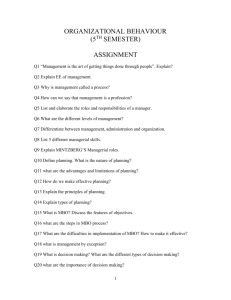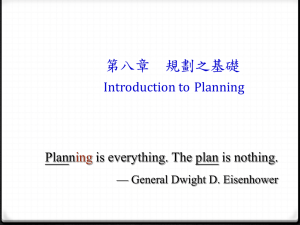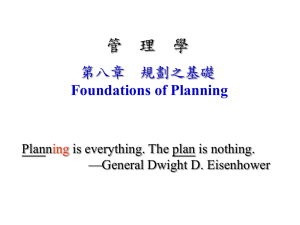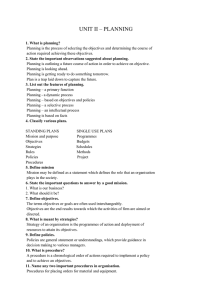Lecture5
advertisement
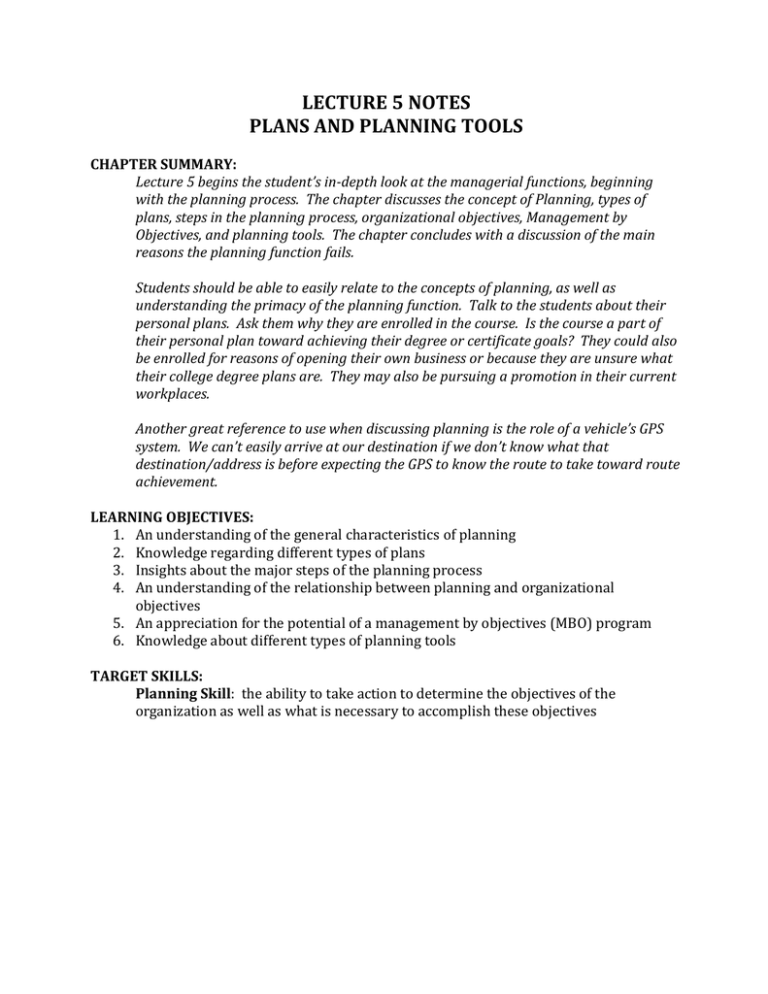
LECTURE 5 NOTES PLANS AND PLANNING TOOLS CHAPTER SUMMARY: Lecture 5 begins the student’s in-depth look at the managerial functions, beginning with the planning process. The chapter discusses the concept of Planning, types of plans, steps in the planning process, organizational objectives, Management by Objectives, and planning tools. The chapter concludes with a discussion of the main reasons the planning function fails. Students should be able to easily relate to the concepts of planning, as well as understanding the primacy of the planning function. Talk to the students about their personal plans. Ask them why they are enrolled in the course. Is the course a part of their personal plan toward achieving their degree or certificate goals? They could also be enrolled for reasons of opening their own business or because they are unsure what their college degree plans are. They may also be pursuing a promotion in their current workplaces. Another great reference to use when discussing planning is the role of a vehicle’s GPS system. We can’t easily arrive at our destination if we don’t know what that destination/address is before expecting the GPS to know the route to take toward route achievement. LEARNING OBJECTIVES: 1. An understanding of the general characteristics of planning 2. Knowledge regarding different types of plans 3. Insights about the major steps of the planning process 4. An understanding of the relationship between planning and organizational objectives 5. An appreciation for the potential of a management by objectives (MBO) program 6. Knowledge about different types of planning tools TARGET SKILLS: Planning Skill: the ability to take action to determine the objectives of the organization as well as what is necessary to accomplish these objectives OUTLINE: This is divided into six sections: 1. General Characteristics of Planning 2. Types of Plans 3. Steps in the Planning Process 4. Organizational Objectives 5. Management by Objectives (MBO) 6. Planning Tools General Characteristics of Planning: This section of the chapter provides an overall, broad look at the definition, purposes, advantages and disadvantages, and primacy of planning. Defining Planning o Planning is the process of determining how an organization can get where it wants to go and what it will do to accomplish its objectives o In a simpler sense, the planning function provides answers to the following two questions: Where are we going? How do we get there? o Planning is a critical management activity regardless of the type or size of organization being managed. Purposes of Planning o Roney - Organizational planning has two types of purposes: Protective – To minimize risk by reducing the uncertainties surrounding business conditions and clarifying the consequences of related management actions Affirmative – To increase the degree of organizational success – Whole Foods relies on this purpose in its planning – the growth of Whole Foods stores is a direct result of careful planning o Another purpose – Establish a coordinated effort within the organization Work toward ensuring integration among an organization’s various business units o Fundamental purpose – to help the organization reach its objectives Koontz/O’Donnell – facilitate the accomplishment of enterprise and objectives All other purposes are spin-offs of this fundamental purpose Planning: Advantages and Disadvantages o Advantages Helps managers to be future-oriented Enhances decision coordination Emphasizes organizational objectives In new businesses and ventures, planning helps ensure sustainability of the business when over 65 percent of all new businesses are known to fail by their fifth anniversary Is important to realize planning does not eliminate all risk, but it does help managers identify and deal with organizational problems before they can create problems for the business o Disadvantages Can take up too much managerial time Does also cause managers to be rigid and may not be able to adapt to new conditions or environmental changes because the change is not in the plan Requires managers to balance between time spent on planning and time spent on organizing, influencing, and controlling Primacy of Planning o Planning in the primary management function o Planning serves as the basis for the organizing, influencing, and controlling functions of management o Only after managers have completed the planning process can they then determine how to structure their organizations through the organizing function, hire employees, lead employees, and monitor/measure progress toward the organization’s objectives accomplishment o Figure 5.1 can be shown to help students understand the Planning function is the foundation for all other managerial functions Types of Plans: This section of the chapter helps students understand the different types of plans, as well as the reality the policies, procedures, rules, and budgets they follow and are impacted by in their jobs are actually a part of the planning process. Two Types of Plans: o Standing Plans – Figure 5.2 and Figure 5.3 Routine plan, used over and over again in organizational situations that occur repeatedly Policies – provides broad guidelines for taking action consistent with reaching organizational objectives Procedures – outlines a series of related actions that must be taken to accomplish a particular task – outline more specific actions than policies do Rules – designates specific required actions – indicates what an organization member should or should not do and allows no room for deviation Steps for Success – provides tips for writing effective policies and procedures o Single-Use Plans – Figure 5.2 Designed to carry out a special project within an organization Exist to achieve a single purpose that helps contribute to the organization’s long-term success Program – designed to carry out a special project within an organization – exists to achieve a purpose that, if accomplished, will contribute to the organization’s long-term success Budget – financial plan covering a specified length of time – details how funds will be spent Steps in the Planning Process: This section of the chapter provides a discussion of the six steps managers should follow during the planning process. It is important to point out to students that this process is dynamic for organizations, just as it is for them in their personal and work lives. Managers need to consistently and continuously revisit the planning process as changes within the managerial environment evolve. Step 1 – State organizational objectives o Managers need to begin the planning process with a clear statement and understanding of the organization’s objectives o Objectives stipulate the areas in which organizational planning will occur Step 2 – List alternative ways of reaching objectives o Managers need to list as many alternatives as possible for reaching the objectives Step 3 – Develop premises on which to base each alternative o The feasibility of using any one alternative to reach organizational objectives is determined by the premises/assumptions the alternative is based on. o Managers need to list these premises and assumptions for all of their objectives. Step 4 – Choose the best alternative for reaching objectives o Alternatives need to be evaluated on the premises/assumptions on which the alternatives are based o When premises/assumptions are found to be unreasonable, an alternative is removed from further consideration o Continuing on this elimination process helps managers determine which alternative best accomplishes an organizational objectives o Further information on the decision-making process involved in this step is found in Chapter 8 Step 5 – Develop plans to pursue the chosen alternative o Once an alternative is chosen, managers begin their strategic/long-range and tactical/short-range plans o Further information on the strategic and tactical planning processes is found in Chapter 9 Step 6 – Put the plans into action o Implement the plans o Organizations do not directly benefit from the planning process until this step is performed o Mention at this point that managers also need to evaluate the plan and make modifications needed, which further demonstrates the fluidity and dynamic nature of the planning process mentioned above. Figure 5.4 shows the sequencing of these six planning process steps Organizational Objectives: Planning’s Foundation: This section of the chapter focuses on organizational objectives – a critical component of the planning process. Definition (and role) of Organizational Objectives o Target toward which the open management system is directed. o Figure 5.5 illustrates how the open management system achieves its organizational objectives o Reflect the purpose (mission) of the organization – what the organization exists to do, given a particular group of customers and customer needs o Flow naturally from the organization’s purpose/mission – When companies achieve their objectives, they are also achieving their purpose/mission o Table 5.1 offers examples of actual company’s purposes – Ask students what their company’s purposes/mission statements are – I have found students will have memorized their employer’s purposes/missions as they are frequently tested on knowing the statements – It is also good to then ask if they believe the company actually demonstrates those purposes/missions through their actions with employees and customers – Ask students what it means when they are not aware of their firm’s purpose/mission – I have found good participation and discussion typically come from this discussion o Organizations exist for various purposes and have various types of objectives o Primary purpose of a business is often to achieve profitability – Ask students if they believe this should be the sole purpose of an organization – or – does focusing on objectives other than profitability (quality, customer satisfaction) naturally result in increased profitability? The book has a nice example of Lincoln Electric Company to use in this discussion. Areas for Organizational Objectives o Introduce Peter Drucker and his involvement in the study of management to the students if you have not done so already. o Drucker advised managers to focus on the following eight key areas to set objectives: Market standing Innovation Productivity Physical and financial resources Profitability Managerial performance and development Worker performance and attitudes Public responsibility o Managers tend to focus objectives on tangible, impersonal characteristics of organizational operation – the first five areas above meet this category. Managers do tend to stay away from the last three areas above because they are personal and objective. Reality is companies should have objectives in all eight areas in order to maximize their probability of success. Working with Organizational Objectives o Appropriate objectives are fundamental to the success of any organization o Organizations set three types of objectives: Short-term objectives – targets to be achieved in one year or less Intermediate-term objectives – targets to be achieved in one to five years Long-term objectives – targets to be achieved in five to seven years o Principle of the Objective – before managers initiate any action, they should clearly determine, understand, and state organizational objectives o Planning for the future often requires an organization to revisit its original objectives. This shows another example of the dynamic nature of the planning process. Audi is used as an example in the text of a manager modifying goals. Guidelines for Establishing Quality Objectives o The quality of goal statements can vary drastically o Guidelines to help increase the quality of objectives include: Let the people responsible for attaining the objectives have a voice in setting them Discuss with students the impact of having a voice in working toward accomplishing their work goals State objectives as specifically as possible Many of your students have probably heard of the acronym, SMART, in relation to goals – Specific – Measurable – Attainable – Realistic - Timely Relate objectives to specific actions whenever necessary Pinpoint expected results Assists with the measuring of goal accomplishment Set goals high enough that employees will have to strive to meet them but not so high that employees will give up trying to meet them Discuss with students the use of “stretch” goals – are managers correct to use these? Can we set the bar so high we shut down employee productivity toward a goal before it actually begins? Specify when goals are expected to be achieved The “Timely” part of SMART goals Set objectives only in relation to other organizational objectives Are the goals connected to the organization’s purpose/mission? State objectives clearly and simply Management by Objectives (MBO): This section of the chapter focuses on Drucker’s MBO approach. Students are typically familiar with MBO, though they may have not heard this name before – but they have typically set goals for a coming year with their manager/supervisor at the time of performance reviews. MBO is a management approach based exclusively on objectives Includes three basic parts: o Individuals within an organization are assigned a specific set of objectives they work toward reaching during a normal operating period. The objectives are mutually set and agreed upon by individual employees and their managers o Performance reviews are conducted periodically to determine how the individual employees are progressing toward attaining their objectives o Rewards are given to employees based on how close they come to achieving their goals Includes five steps – Figure 5.6 illustrates the connection of the five steps o Review organizational objectives – Manager needs to share the organization’s purpose/mission and objectives with the employee o Set worker objectives – Manager and employee work together to set objectives the employee will work toward accomplishing during the year (or other time period the organization uses) o Monitor progress – Manager meets with employee at time intervals set by the firm to review the employee’s progress toward accomplishing their assigned objectives – This is a key element for the MBO program – if managers only meet with employees at the time of their performance review, the benefits of the MBO program are lost for the employee…and the firm. o Evaluate performance – At the end of the year (or other time period the organization uses), the employee’s performance is evaluated based on the extent to which the employee met his/her objectives o Give rewards – Rewards are allocated/assigned based on the extent to which the objectives have been accomplished and reached Factors Necessary for a Successful MBO Program o Top management must be committed to the MBO process and set appropriate objectives for the overall organization o Managers and employees together must develop and agree on each individual’s goals o Employee performance should be conscientiously evaluated against established objectives o Management must follow through on employee performance evaluations by rewarding employees accordingly MBO Programs: Advantages and Disadvantages o Advantages: MBO programs continually emphasize what should be done in an organization to achieve organizational goals MBO process secures employee commitment to attaining organizational goals o Disadvantages: Development of objectives can be time-consuming, leaving all parties (managers and employees) with less time to do their actual work Elaborately written goals, careful communication of goals, and detailed performance evaluations required in an MBO program increase the volume of paperwork in the organization Planning Tools: This section of the chapter offers techniques managers can use to help develop their plans. Additionally the forecasting and scheduling processes are discussed – as is the potential for companies to fail even after completing the planning process. Forecasting o The process of predicting future environmental happenings that will influence the operation of the organization o Importance of forecasting lies in its ability to help managers understand the future makeup of the organizational/managerial environment, which in turn helps them formulate more effective plans o Is an imprecise science – research shows forecasts are typically off by 20 percent – this results in the need for managers to continually search for more accurate forecasting tools o Tips for Managing the Globe in the text discusses the use of forecasting raw materials at Mars, Inc. o How Forecasting Works Text example discusses William House and his description of Insect Control Services Company as an illustration of how forecasting works Establish relationships between industry sales and national economic and social indicators Determine impact of government restrictions on use of chemical pesticides in the pest-control markets Evaluate sales growth potential, profitability, resources required, and risks involved in market areas Evaluate potential for expansion of marketing efforts across geographic markets Determine likelihood of technology breakthroughs and advancements that make existing product lines obsolete o Types of Forecasts Sales forecast – prediction of high and low sales volume for the organization over a period of time – the sales forecast serves as the fundamental guideline for planning Other types include economic, technology, social trends o Methods of Sales Forecasting Qualitative Methods Jury of Executive Opinion Method – straightforward method asking appropriate managers to give opinions on what will happen to sales in the future Delphi Method – gathers, evaluates, and summarizes expert opinions as the basis for the forecast – more formal than Jury of Executive Opinion Method – Includes the following six steps: o Step 1 – Experts are asked to answer independently and in writing a series of questions about the future of sales or other areas involved in the forecast o Step 2 – Summary of answers is prepared with answers anonymously included o Step 3- Copies of summary are given to all individual experts with requests to modify their answers as needed o Step 4 – Second summary of answers is prepared and distributed. Any further deviations have to be justified in writing o Step 5 – Third summary is prepared and distributed – justifications for ALL answers are now required o Step 6 – Forecast is generated from the opinions and justifications that come out of step 5 Sales Force Estimation Method – Predicts future sales by analyzing opinions of salespeople as a group – the resulting forecast is a blend of the informed views of the group o This method is seen universally throughout the world as being generally good, though managers have found it can be improved by taking the simple steps of ensuring sales staff have ample time to forecast and incentives are offered for accurate forecasts. Quantitative Methods Moving Average – Utilizes historical data to predict future sales levels resulting in average sales levels for x historical time periods – The book includes an example of Toyota using a fiveyear moving average to predict future automobile sales Regression – Predicts future sales by analyzing the historical relationship between sales and time – This information is then used to prepare a trend line that best illustrates the historical relationship between sales and time – Figure 5.7 in the book provides an illustrated example of a trend line used to forecast future sales Product Stages – Utilizes the product life cycle stages (illustrated in Figure 5.8) – This method shows how the five stages of the product life cycle are related to sales volume for seven products over a period of time – Use of this method may allow managers to prevent some products from entering the decline stage by improving product quality or by adding innovations o Evaluating Sales Forecasting Methods The methods above are not the only ones available for managers In practice, managers find each sales forecasting method has distinct advantages and distinct disadvantages Best decision is typically to use a combination of methods to forecast sales rather than just one method Research shows combining quantitative and qualitative forecasting methods results in better forecasts Whichever one is chosen has to fit the needs of the organization and can be adapted to changes in the managerial environment Table 5.2 in the text provides an illustration and discussion of the use of forecasting methods over time Scheduling o Process of formulating a detailed listing of activities that must be accomplished to attain an objective, allocating the resources necessary to attain the objective, and setting up and following time tables for completing the objective o Practical Challenge: Meeting Schedules “Clark/McCarthy Joint Venture Builds Navy Hospital Ahead of Schedule” provides an example of the use of scheduling a complex project Gantt Charts Developed by Henry L. Gantt Bar graph with time on the horizontal axis and resources to be scheduled on the vertical axis Used to schedule resources needed Figure 5.9 in text illustrates the use of a Gantt chart to schedule Workweek 28 activities for Wendy Reese and Peter Thomas – walking students through this example provides a good look at the value of Gantt charts as a summary overview of how organizational resources are being used Program Evaluation and Review Technique (PERT) Technique developed partly from the Gantt chart, but also includes a tool that does emphasize the interrelationship of tasks that the Gantt charts do not include A network of project activities showing both the estimates of time necessary to complete each activity, as well as the sequence of activities that must be followed to complete the project Contains two primary elements: o Activity – specified set of behaviors within a project o Event – completion of major product tasks o Each event is assigned corresponding activities that must be performed before the event can materialize Figure 5.10 in text provides an illustration of a sample PERT network designed for building a house Critical Path – that part of the PERT network requiring the longest period of time to complete – A delay in completing this sequence results in a delay in completing the entire project Steps in Designing a PERT Network o Step 1 – List all activities/events that must be accomplished for a project and the sequence in which these activities and events should be performed o Step 2 – Determine how much time is needed to complete each activity and event o Step 3 – Design a PERT network that reflects all of the information contained in steps 1 and 2 o Step 4 – Identify the critical path Why Plans Fail o Understanding why plans fail helps managers take the necessary steps to eliminate the factors that cause failure and thereby increase the probability that their plans will be successful o Study by Ringbakk showed plans fail when: Corporate planning is not integrated into the total management system Lack of understanding exists in the different steps of the planning process Managers at different levels of the organization have not properly engaged in or contributed to planning activities Responsibility for planning is incorrectly vested solely in the planning department Management expects that plans developed will be realized with little effort In starting formal planning, too much is attempted at once Managers fail to operate by the plan Financial projections are confused with planning Inadequate inputs are used in planning Management fails to grasp the overall planning process o Managers need to understand failed plans do not always lead to permanent business failures – sometimes a failing plan can be salvaged through an adjustment or bit of fine-tuning o Plan B – contingency plan – may just be the right fit to avoid total failure

